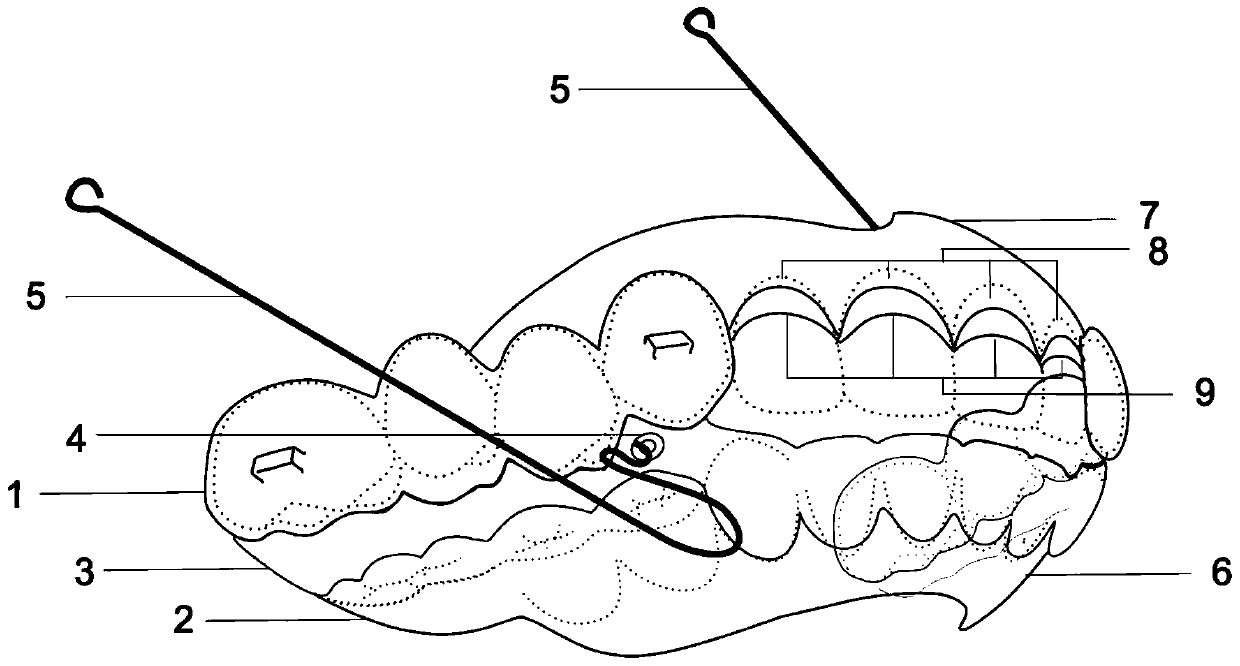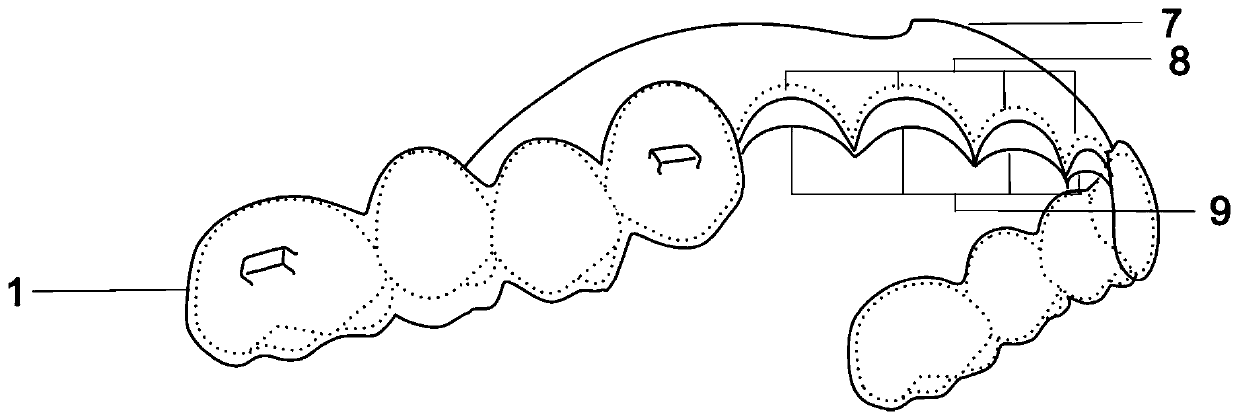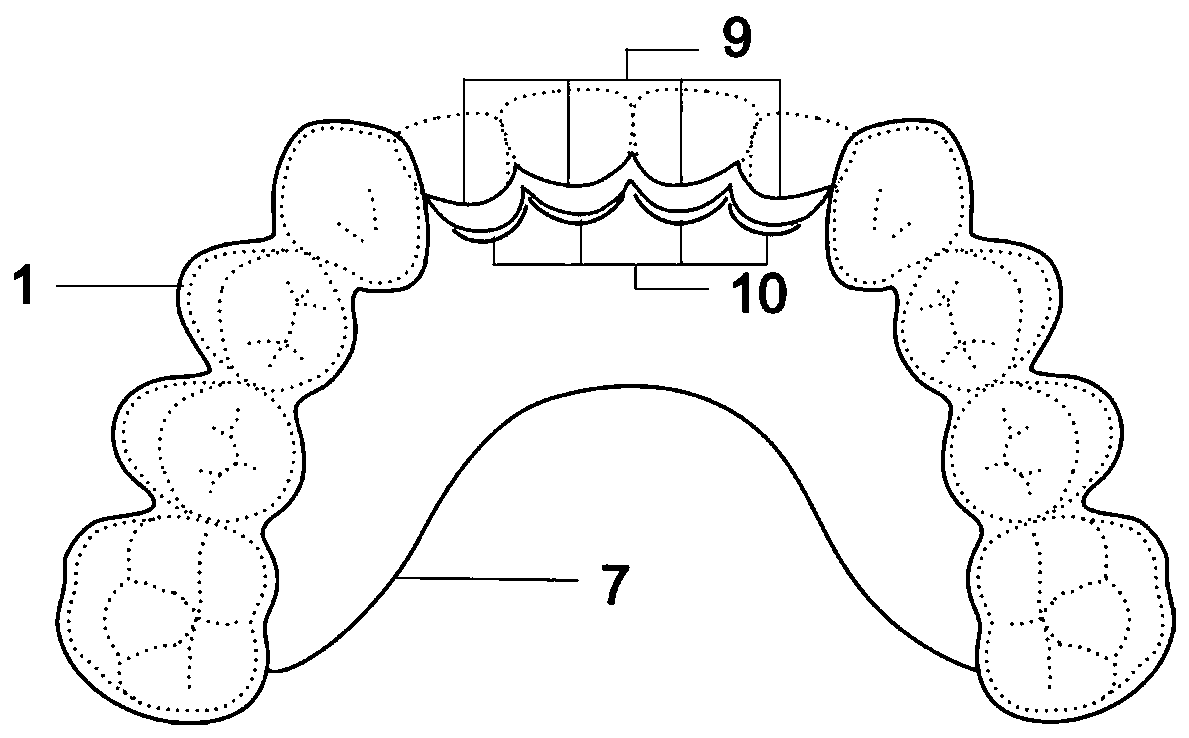Invisible appliance
An invisible appliance and appliance technology, applied in the field of stomatology, can solve problems such as depressing anterior teeth to open occlusion, limited clinical application scope, inability to treat Class III malocclusion, etc., achieving soft and continuous orthodontic force and clinical application. widening and improving the efficacy of orthodontic treatment
- Summary
- Abstract
- Description
- Claims
- Application Information
AI Technical Summary
Problems solved by technology
Method used
Image
Examples
Embodiment 1
[0046] In this embodiment, an invisible appliance according to the present invention is used to treat patients with skeletal class II malocclusion with deep overbite of anterior teeth. As shown in Figure 3, it includes a double-jaw appliance and a single-jaw appliance. The double-jaw appliance includes a maxillary brace 1, a mandibular brace 2, a connecting occlusal plate 3, a lingual guide wing 6, a palatal side plate 7, and an anterior occlusal opening. Assemblies, the single-jaw appliance includes a maxillary brace 1, a palatal plate 7, and an anterior occlusal opening assembly, and the anterior occlusal opening assembly includes a gingival margin bulge 8 and a booster pad 9. Each part of the invisible aligner is made of transparent material. The maxillary mouthpiece 1 covers the buccolingual sides from the maxillary canines to the first molars, and the mandibular mouthpiece 2 covers the lingual side of the mandibular dentition and the labial side of the mandibular anterior...
Embodiment 2
[0051] In this embodiment, an invisible appliance according to the present invention is used to treat patients with osteofacial type II malocclusion accompanied by vertical and / or sagittal overgrowth of the maxilla, such as Figure 4 , including the upper jaw brace 1, the lower jaw brace 2, the connecting splint 3, the outer tube 4, the extraoral traction arch 5, and the lingual guide wing 6, and each part of the invisible appliance is made of transparent materials. The maxillary braces 1 cover the entire maxillary dentition, and the mandibular braces 2 cover the lingual side of the mandibular dentition and the labial side of the mandibular anterior region; In between, connect the maxillary braces and the mandibular braces as a whole, and fix the position of the maxillary braces and the mandibular braces at the target position after occlusal reconstruction, thereby playing the role of leading the mandible; the outer tube 4 is located on the buccal side connecting the occlusal pl...
Embodiment 3
[0055] In this embodiment, an invisible appliance according to the present invention is used to treat patients with mild Class III malocclusion. Such as Figure 5, including maxillary braces 1, mandibular braces 2, connecting occlusal plate 3, lingual guide wing 6, palatal side plate 7, gingival margin bulge 8 and booster pad 9. Each part of the invisible aligner is made of transparent material. The maxillary mouthpiece 1 covers the buccolingual side of the maxillary canines to the first molar, the mandibular mouthpiece 2 covers the occlusal 1 / 2 of the crown-lingual side and the crown-labial side of the mandibular anterior teeth; 3 Located between the occlusal surfaces of the upper and lower jaw braces after occlusal reconstruction, connecting the upper jaw braces and the lower jaw braces into one, fixing the positional relationship between the upper jaw braces and the lower jaw braces at the target position after occlusal reconstruction, so as to play the role of retreating ...
PUM
 Login to View More
Login to View More Abstract
Description
Claims
Application Information
 Login to View More
Login to View More - R&D
- Intellectual Property
- Life Sciences
- Materials
- Tech Scout
- Unparalleled Data Quality
- Higher Quality Content
- 60% Fewer Hallucinations
Browse by: Latest US Patents, China's latest patents, Technical Efficacy Thesaurus, Application Domain, Technology Topic, Popular Technical Reports.
© 2025 PatSnap. All rights reserved.Legal|Privacy policy|Modern Slavery Act Transparency Statement|Sitemap|About US| Contact US: help@patsnap.com



